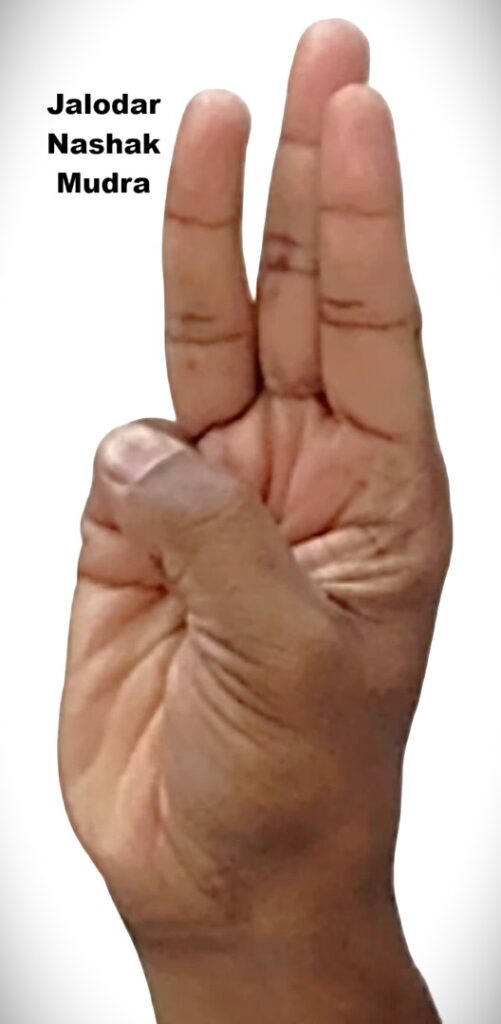Jalodar Nāshak Mudra
Introduction
Jalodar Nāshak Mudra is a therapeutic yogic hand gesture designed to reduce excess water retention in the body. The Sanskrit word Jalodar refers to ascites (abnormal accumulation of fluid in the abdominal cavity), while Nāshak means destroyer or remover. This mudra is traditionally practiced to balance the water element (jala tattva), improve digestion, and regulate fluid metabolism.
Meaning
Jala (Water): Represents the water element in the body, associated with fluid balance, circulation, and emotions.
Udara (Belly/Abdomen): Refers to abdominal fluid accumulation.
Nāshak (Destroyer): Signifies removal or reduction.
Mudra (Gesture): A symbolic hand gesture that redirects pranic energy.
Thus, Jalodar Nāshak Mudra means “the gesture that removes excess water or fluid from the abdomen/body.”
How to Perform (Method of Practice)
Step-by-Step Instructions:
Sit comfortably in Padmasana (Lotus Pose), Sukhasana (Easy Pose), or on a chair with spine erect.
Rest your hands on your thighs with palms facing upward.
Bend the little finger to the base of the thumb.
Place the thumb gently over the little finger, applying light pressure.
Keep the other fingers (index, middle, ring) extended but relaxed.
Close your eyes, breathe slowly and deeply.
Focus your awareness on the abdominal region, visualizing excess water being released.
Practice Tip: Perform this mudra in a calm environment, preferably after meals or during meditation.
Benefits
Physical Benefits:
Helps in reducing water retention, swelling, and edema.
Supports the management of ascites (fluid in abdomen).
Improves digestion and assimilation of food.
Assists the urinary system in expelling excess fluids.
Balances Swadhisthana chakra (water element center).
Mental & Emotional Benefits:
Reduces feelings of heaviness, lethargy, and sluggishness.
Promotes mental clarity and emotional stability.
Spiritual Benefits:
Encourages balance of the jala tattva (water element).
Aids in cleansing the body energetically and emotionally.
Contraindications
Should be avoided by people with extreme dehydration or low fluid levels.
Not recommended for those with chronic dryness in the body (dry skin, constipation due to lack of water).
Pregnant women should practice only under guidance.
Should not replace medical treatment for serious abdominal disorders—use only as supportive therapy.
Anatomy & Physiology
Musculoskeletal: Involves flexion of the little finger and pressure from the thumb, engaging intrinsic hand muscles.
Digestive System: Helps in stimulating digestion and preventing fluid accumulation in the abdomen.
Urinary System: Supports kidney and bladder function by enhancing excretion of water.
Circulatory System: May improve lymphatic drainage and reduce bloating.
Kinesiology
Involves finger flexion (little finger) and oppositional grip (thumb).
Creates tension in hand muscles, stimulating reflex zones associated with water balance.
Promotes neuromuscular awareness through tactile feedback.
Neurology
Stimulates sensory nerve endings in the fingers that connect to brain regions regulating autonomic functions.
Enhances parasympathetic activation, encouraging relaxation and metabolic balance.
Indirectly influences the hypothalamus-pituitary axis, which regulates fluid balance.
Duration of Practice
Beginners: 10–15 minutes per session.
Intermediate/Advanced: 20–30 minutes, 2–3 times daily.
Best practiced on an empty stomach or after digestion.
Counter Mudra
Varun Mudra (thumb + little finger tips together) can be used as a counter practice to increase water element if dryness occurs.
Prithvi Mudra can also be alternated to maintain balance of the earth element.
Conclusion
Jalodar Nāshak Mudra is a therapeutic hand gesture for reducing excess water in the body and promoting digestive and urinary health. It is highly beneficial for conditions like ascites, edema, and bloating, while also calming the mind. When practiced consistently with proper lifestyle habits, this mudra can restore balance to the water element, leading to improved health and vitality.
FAQ
Q1: Can Jalodar Nāshak Mudra cure ascites completely?
No, it is a supportive practice. Medical treatment is essential for serious conditions.
Q2: How soon can results be felt?
Relief from heaviness and bloating may be noticed within a few sessions; deeper benefits may take weeks.
Q3: Can children practice this mudra?
Yes, for short durations under supervision.
Q4: Is it safe during pregnancy?
Not recommended unless guided by an experienced yoga therapist.
Q5: Can it be done lying down?
It is best done while sitting upright to promote proper pranic flow.
References
Swami Satyananda Saraswati. Asana, Pranayama, Mudra, Bandha. Yoga Publications Trust.
Gertrud Hirschi. Mudras: Yoga in Your Hands.
Dr. B.K. Taimni. The Science of Yoga.
T.K.V. Desikachar. The Heart of Yoga.
Research articles on yoga mudras and fluid balance in holistic therapies.

